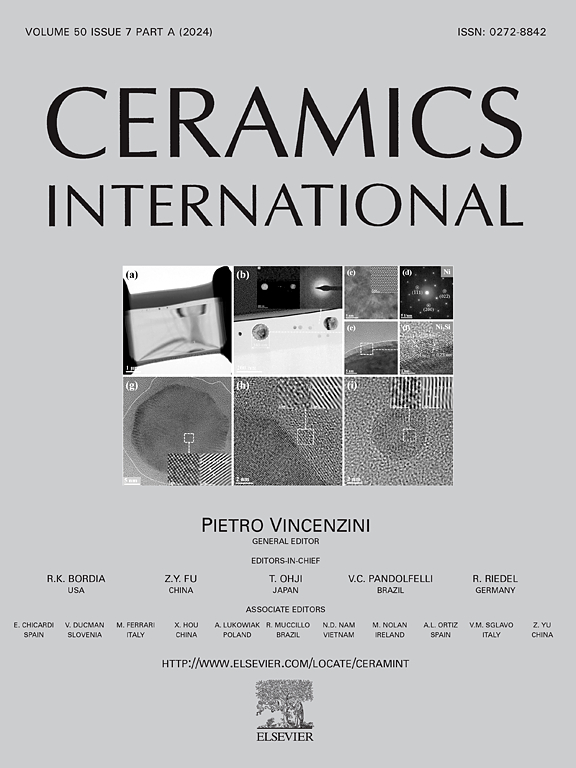Exploring swift heavy ion irradiation effects on ZnGa2O4 thin films for optoelectronic applications
IF 5.6
2区 材料科学
Q1 MATERIALS SCIENCE, CERAMICS
引用次数: 0
Abstract
Swift heavy ion (SHI) irradiation has emerged as a powerful technique for tailoring material's structural and functional properties. This study investigated the effect of 120 MeV swift gold ion irradiation on the ZnGa2O4 thin film, with ion fluences ranging from 1012 to 1013 ions cm˗2. The X-ray diffraction results reveal the radiation hardness of the ZnGa2O4, showing phase stability up to a fluence of 1013 ions cm˗2. The concentration of irradiation-induced oxygen vacancies was quantified and found to increase with rising ion fluence. Furthermore, the impact on surface wetting properties was analyzed, revealing a transition from hydrophobic to hydrophilic behavior with contact angles ranging from 103.4° to 84.8°. The bare and irradiated thin-film transmission line measurements were conducted, showing changes in the electrical properties, with the sheet resistance decreasing from 290 MΩ/□ to 1.91 MΩ/□. This study demonstrates the potential of swift heavy ion irradiation as a tool for tuning the optical and electrical properties of ZnGa2O4 for optoelectronic applications.
光电应用中ZnGa2O4薄膜的快速重离子辐照效应研究
快速重离子(SHI)辐照已成为一种用于改变材料结构和功能特性的强大技术。本文研究了120 MeV快速金离子辐照对ZnGa2O4薄膜的影响,离子影响范围为1012 ~ 1013个离子,对其进行一定的研究。x射线衍射结果揭示了ZnGa2O4的辐射硬度,并显示出高达1013个离子的相稳定性2。对辐照引起的氧空位浓度进行了定量分析,发现其随离子浓度的增加而增加。此外,分析了对表面润湿性能的影响,揭示了从疏水到亲水性的转变,接触角在103.4°到84.8°之间。对裸线和辐照后的薄膜传输线进行了测量,显示了电学性能的变化,片电阻从290 MΩ/□下降到1.91 MΩ/□。这项研究证明了快速重离子辐照作为一种调整ZnGa2O4光电子应用的光学和电学特性的工具的潜力。
本文章由计算机程序翻译,如有差异,请以英文原文为准。
求助全文
约1分钟内获得全文
求助全文
来源期刊

Ceramics International
工程技术-材料科学:硅酸盐
CiteScore
9.40
自引率
15.40%
发文量
4558
审稿时长
25 days
期刊介绍:
Ceramics International covers the science of advanced ceramic materials. The journal encourages contributions that demonstrate how an understanding of the basic chemical and physical phenomena may direct materials design and stimulate ideas for new or improved processing techniques, in order to obtain materials with desired structural features and properties.
Ceramics International covers oxide and non-oxide ceramics, functional glasses, glass ceramics, amorphous inorganic non-metallic materials (and their combinations with metal and organic materials), in the form of particulates, dense or porous bodies, thin/thick films and laminated, graded and composite structures. Process related topics such as ceramic-ceramic joints or joining ceramics with dissimilar materials, as well as surface finishing and conditioning are also covered. Besides traditional processing techniques, manufacturing routes of interest include innovative procedures benefiting from externally applied stresses, electromagnetic fields and energetic beams, as well as top-down and self-assembly nanotechnology approaches. In addition, the journal welcomes submissions on bio-inspired and bio-enabled materials designs, experimentally validated multi scale modelling and simulation for materials design, and the use of the most advanced chemical and physical characterization techniques of structure, properties and behaviour.
Technologically relevant low-dimensional systems are a particular focus of Ceramics International. These include 0, 1 and 2-D nanomaterials (also covering CNTs, graphene and related materials, and diamond-like carbons), their nanocomposites, as well as nano-hybrids and hierarchical multifunctional nanostructures that might integrate molecular, biological and electronic components.
 求助内容:
求助内容: 应助结果提醒方式:
应助结果提醒方式:


